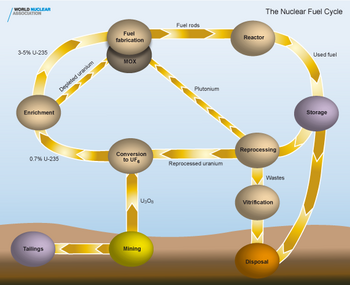Uranium fuel cycle: Difference between revisions
Jump to navigation
Jump to search

imported>Pat Palmer (adding seealso template) |
(add figure on fuel cycle) |
||
| Line 1: | Line 1: | ||
{{seealso|Nuclear_power_reconsidered}} | {{seealso|Nuclear_power_reconsidered}} | ||
{{Image|Uranium Fuel Cycle.png|right|350px|The complete uranium fuel cycle, showing primary and recycled materials flow.<ref>[https://world-nuclear.org/information-library/nuclear-fuel-cycle/conversion-enrichment-and-fabrication/fuel-fabrication.aspx world-nuclear.org/information-library/nuclear-fuel-cycle/conversion-enrichment-and-fabrication/fuel-fabrication.aspx]</ref>}} | |||
This article should address the issues raised by opponents of nuclear power, including hazards and environmental impacts at every step from mining to final disposal of radioactive waste. | This article should address the issues raised by opponents of nuclear power, including hazards and environmental impacts at every step from mining to final disposal of radioactive waste. | ||
| Line 5: | Line 6: | ||
There is only one fissile nuclide occurring in nature - uranium 235, which is a small fraction of naturally occurring uranium. Other fissile nuclides may be produced by neutron irradiation of much more abundant "fertile" nuclides. | There is only one fissile nuclide occurring in nature - uranium 235, which is a small fraction of naturally occurring uranium. Other fissile nuclides may be produced by neutron irradiation of much more abundant "fertile" nuclides. | ||
== Nuclear transmutations == | |||
Fissile U-235, 0.7% of natural uranium, crustal abundance 19.44 ppb, 4.83 MJ/liter. | Fissile U-235, 0.7% of natural uranium, crustal abundance 19.44 ppb, 4.83 MJ/liter. | ||
: <math>^{235}_{92}U</math> → Fission Products + 211.3 MeV → 86.75 TJ/kg | : <math>^{235}_{92}U</math> → Fission Products + 211.3 MeV → 86.75 TJ/kg | ||
| Line 13: | Line 15: | ||
Fertile Th-232, crustal abundance 12ppm, 2,813 MJ/liter. | Fertile Th-232, crustal abundance 12ppm, 2,813 MJ/liter. | ||
: <math>^{232}_{90}Th</math> → <math>^{233}_{92}U</math> → Fission Products + 200.1 MeV → 82.86 TJ/kg | : <math>^{232}_{90}Th</math> → <math>^{233}_{92}U</math> → Fission Products + 200.1 MeV → 82.86 TJ/kg | ||
== Notes and references == | |||
{{reflist}} | |||
Latest revision as of 16:23, 20 April 2022
- See also: Nuclear_power_reconsidered

© Image: World Nuclear Association
The complete uranium fuel cycle, showing primary and recycled materials flow.[1]
The complete uranium fuel cycle, showing primary and recycled materials flow.[1]
This article should address the issues raised by opponents of nuclear power, including hazards and environmental impacts at every step from mining to final disposal of radioactive waste.
There is only one fissile nuclide occurring in nature - uranium 235, which is a small fraction of naturally occurring uranium. Other fissile nuclides may be produced by neutron irradiation of much more abundant "fertile" nuclides.
Nuclear transmutations
Fissile U-235, 0.7% of natural uranium, crustal abundance 19.44 ppb, 4.83 MJ/liter.
- → Fission Products + 211.3 MeV → 86.75 TJ/kg
Fertile U-238, 99.3% of natural uranium, crustal abundance 2.7 ppm, 652 MJ/liter.
- → → Fission Products + 211.5 MeV → 85.38 TJ/kg
Fertile Th-232, crustal abundance 12ppm, 2,813 MJ/liter.
- → → Fission Products + 200.1 MeV → 82.86 TJ/kg




